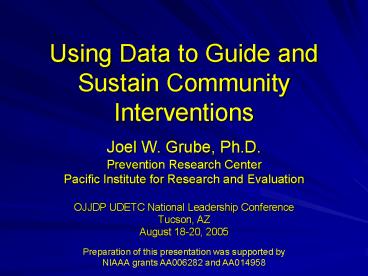Using Data to Guide and Sustain Community Interventions - PowerPoint PPT Presentation
1 / 26
Title:
Using Data to Guide and Sustain Community Interventions
Description:
Using Data to Guide and Sustain Community Interventions Joel W. Grube, Ph.D. Prevention Research Center Pacific Institute for Research and Evaluation – PowerPoint PPT presentation
Number of Views:110
Avg rating:3.0/5.0
Title: Using Data to Guide and Sustain Community Interventions
1
Using Data to Guide and Sustain Community
Interventions
- Joel W. Grube, Ph.D.Prevention Research
CenterPacific Institute for Research and
EvaluationOJJDP UDETC National Leadership
ConferenceTucson, AZAugust 18-20, 2005
Preparation of this presentation was supported
byNIAAA grants AA006282 and AA014958
2
What is Sustainability?
- Sustainability addresses three issues
- Maintaining the benefits of a program
- Continuing a program
- Building the capacity to continue a program
- Broadly speaking sustainability refers to
- The process of ensuring an adaptive preventive
system can be integrated into ongoing
operations to benefit diverse stakeholders. - (Johnson, Hayes, Center, Daley, 2004, p. 137)
3
Key Issues in Sustainability
- Sustainability is an ongoing dynamic process
- Sustainability is an adaptive process
- Sustainable innovation is integrated into normal
operations and requires adequate infrastructure
capacity - Sustainable innovation should have proven benefit
to diverse stakeholders - Sustainability requires commitment and
support Champions Decision-makers Stakeholders
Workers
Source Johnson, Hayes, Center, Daley, 2004
4
Model of Sustainability
Assess Plan Implement Evaluate Reassess/Modify
Capacity Building
Sustainable Innovation Continuation
Innovation Integration into System
Stakeholder Benefits
Data
Source Johnson, Hayes, Center, Daley, 2004
5
Some Examples Using DataOregon Youth Alcohol
Access ProjectCommunity Trials Project to Reduce
Alcohol TraumaDiadema Project
6
AssessIs there a problem?What is the problem?
7
30-Day DrinkingOregon 11th Graders
Half of Oregon 11th graders report drinking in
the past 30 days.
Source Oregon Healthy Teens Survey
2005http//oregon.gov/DHS/ph/chs/youthsurvey/yrbs
data.shtml
8
30-Day 5 DrinksOregon 11th Graders
Of those Oregon 11th graders who report drinking
in the past 30 days, 60 report having 5 drinks.
Source Oregon Healthy Teens Survey
2005http//oregon.gov/DHS/ph/chs/youthsurvey/yrbs
data.shtml
9
30-Day Drug Use Among Oregon 11th Graders
Alcohol is by far the most commonly used and
abused drug among Oregon 11th graders.
Source Oregon Healthy Teens Survey
2005http//oregon.gov/DHS/ph/chs/youthsurvey/yrbs
data.shtml
10
Drinking Problems Among Oregon 11th Grade Drinkers
Source Oregon Healthy Teens Survey
2005http//oregon.gov/DHS/ph/chs/youthsurvey/yrbs
data.shtml
11
Annual Costs of Underage Drinking in Oregon
2001(Millions of Dollars)
Total Costs 697 million annually
387 per capita per year
Source Enforcing Underage Drinking Laws
Website http//www.udetc.org/UnderageDrinkingCost
s.asp
12
Annual Costs of Underage Drinking in Oregon (2001)
Problem Total Costs (Millions)
Youth Violence 351.5
Youth Traffic Crashes 86.1
High Risk Sex 59.6
Youth Property Crime 49.1
Youth Injury 36.7
Poisonings Psychoses 11.8
FAS Mothers Age 15-20 11.7
Youth Alcohol Treatment 90.5
Total 697.2
Source Enforcing Underage Drinking Laws
Website http//www.udetc.org/UnderageDrinkingCost
s.asp
13
PlanningWhere do we intervene?How?
14
Ease of Obtaining Alcoholby Oregon 11th Graders
Over 81 of Oregon 11th graders say it would be
very easy or sort of easy to get alcohol if they
wanted
Source Oregon Healthy Teens Survey
2005http//oregon.gov/DHS/ph/chs/youthsurvey/yrbs
data.shtml
15
Sources of Alcohol Past 30 Days by Oregon 11th
Graders
Commercial
Social
Oregon teens use multiple sources to obtain
alcohol
Source Dent, Grube, Biglan, 2005
16
Other Key Findings
- Drinking increases as perceived commercial and
social availability increases - Drinking increases as perceived enforcement of
MIP laws decreases - Use of social sources increases as commercial
availability decreases - Use of commercial sources increases as social
availability decreases
Dent, Grube, Biglan, 2005
17
Indicated Points of Intervention
- Commercial AvailabilityReward and
ReminderCompliance Checks - Social AvailabilityShoulder TapsParty
DispersalMIP - Targeted Media
18
- Monitor Implementation
- What is being done?
- What dosage?
19
Underage Access ActivitiesCommunity Trials
Project
Pre-intervention
Intervention Period
Source Grube, 1997
20
- Evaluate/Assess
- What effects?
- What benefits?
21
Effects of Reward and Reminder on Tobacco Sales
Baseline
Post Intervention
Biglan, Ary, Smolkowski, Duncan, Black, 2000
22
Effects of Reward and Reminderon Weekly Alcohol
Use
Biglan, Ary, Smolkowski, Duncan, Black, 2000
23
Homicides per 1,000 ResidentsDiadema, Brazil
After Restriction
Before Sales Hours Restriction
There were an average of 301.3 homicides per year
before the sales restrictions and 169.6 per year
afterward
Duailibi, Laranjeira, Ponicki, Grube, Lacey,
2005
24
Estimated Effects of ReducingHours of Sales
Number of Lives Saved 273
95 CI 208-338
Reduction in Homicides 46.1
Number of Assaults Prevented 224
95 CI -66 514
Reduction in Assaults 25.8
Duailibi, Laranjeira, Ponicki, Grube, Lacey,
2005
25
- Reassess/Modify
- What is not working?
- What should be changed?
- Where are more resources needed?
26
Effects of Compliance Checks and RBS on Underage
Sales
Source Grube, 1997
27
Public Support
- Is there public support?
28
Percent of US Population Supporting Alcohol
Policies
Proposed Policy FavorStrongly FavorSomewhat OpposeSomewhat Oppose Strongly
Increase alcohol taxes by 5 cents to fund prevention 65.0 16.8 5.7 12.6
Restrict alcohol ads to make drinking less appealing to youth 52.6 26.0 10.5 10.8
Conduct compliance checks 46.5 19.0 9.5 25.0
Require keg registration 39.9 21.3 15.3 23.5
Source Harwood, Wagenaar, Zander, 1998
29
Conclusion
- Data can guide and sustain programs
- Define the problem and the solution
- Plan and target interventions
- Monitor implementation
- Evaluate outcomes
- Reassess and modify interventions
- Marshall support for increased allocation of
resources and infrastructure capacity
30
- Key reference
- Johnson, K., Hays, C., Center, H., Daley, C.
(2004). Building capacity and sustainable
prevention innovations A sustainability
planning model. Evaluation and Program Planning,
27, 135-149.































